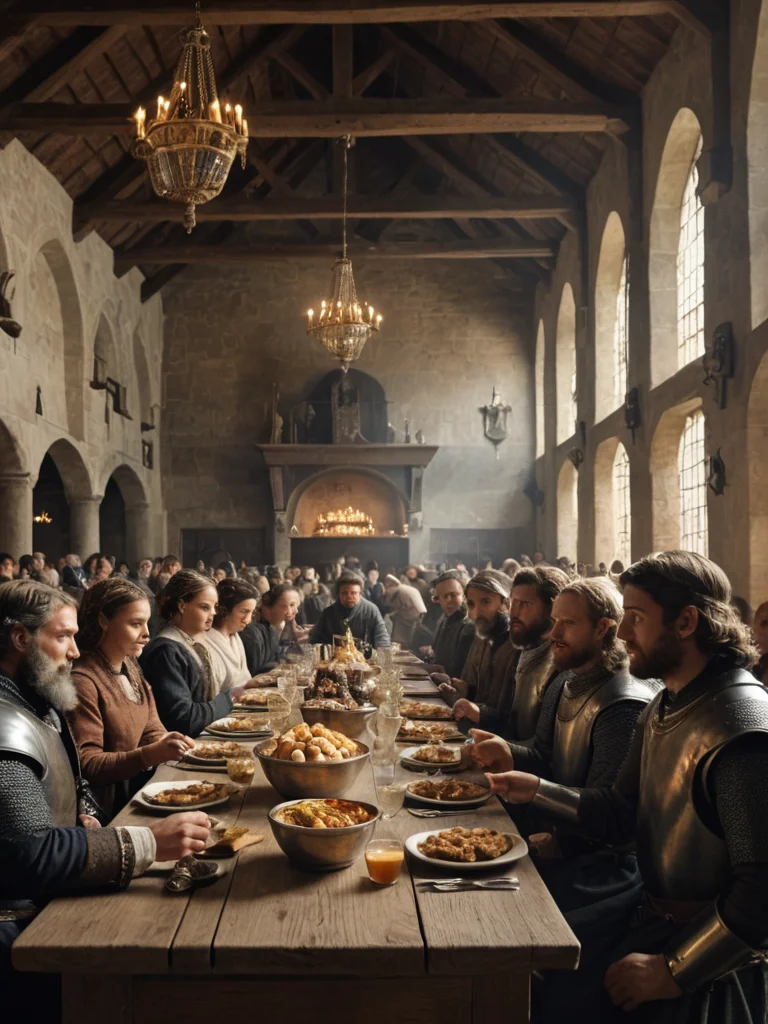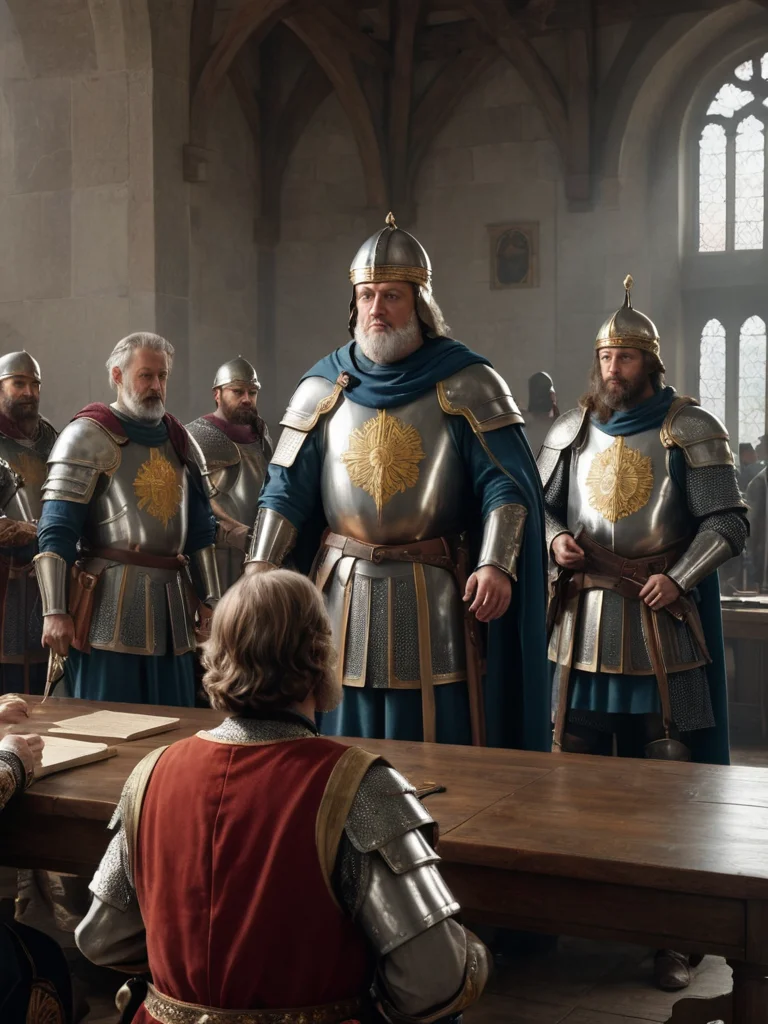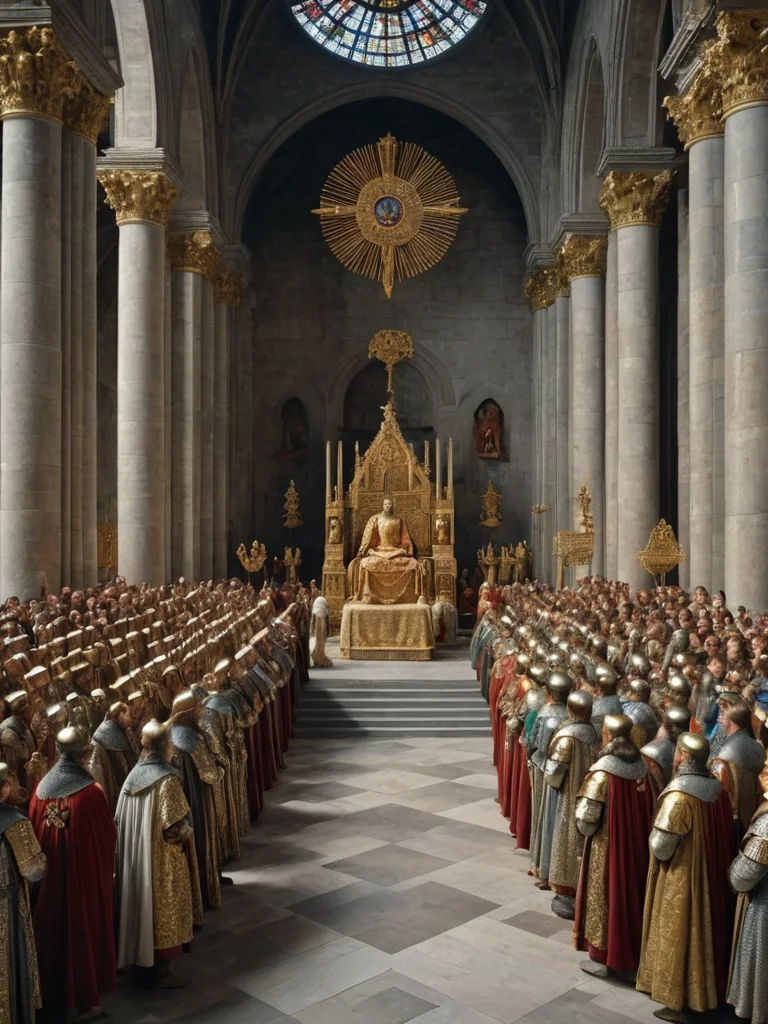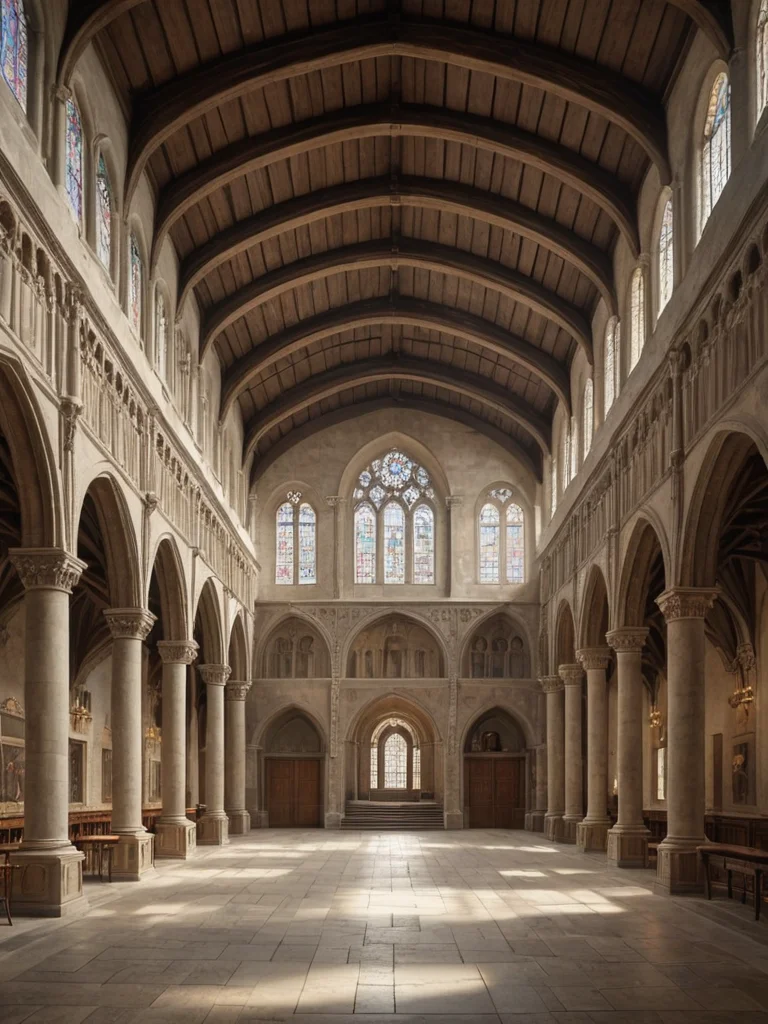When we utter the name Charlemagne, an image of a mighty ruler, who united vast territories under his scepter and revived the idea of the Western Roman Empire, inevitably appears before our inner eye. Historians unanimously recognize him as one of the key figures of the European Middle Ages, whose reign marked an era of revival – the Carolingian Renaissance. However, behind the brilliance of coronations and the grandeur of military campaigns lay everyday life, filled with its own rules, traditions, and a unique way of life that is often far from our modern notions of luxurious palaces and refined manners.
Welcome to the Palace: What Was the Daily Life of Charlemagne’s Court Like?
Imagine not just a royal residence, but an entire mobile city. Charlemagne’s court was not tied to one permanent location, like Versailles of Louis XIV or the Winter Palace in St. Petersburg. Instead, it constantly moved across the vast territories of the Frankish Kingdom, stopping at imperial villas – the so-called villae regiae or palatia – scattered throughout his empire. This movement was not a whim, but a necessity: it ensured direct administration of the provinces, collection of taxes and duties, and the supply of provisions for the court itself, which numbered hundreds, and at times, thousands of people.
The arrival of the imperial court at any given villa was a grand event. It required colossal logistical efforts. Imagine convoys with household items, the chancellery, the emperor’s personal belongings, and an endless stream of people: advisors, military leaders, scholars, clergy, servants, artisans, soldiers, and even family members. All of this moved along roads that often left much to be desired. Each stop turned into a temporary center of power, justice, and culture, where state affairs were decided, courts were held, ambassadors were received, and future elites were educated.
The very word “palace” in those times had a different meaning than today. They were not so much architectural masterpieces as functional complexes of buildings, including living quarters for the emperor and his family, halls for audiences and feasts, chapels, chanceries, utility buildings, stables, and even prisons. Charlemagne’s main residence in Aachen, although the most developed, was more of an extensive complex than a single grand structure. Baths inspired by Roman thermae, a large assembly hall, and the famous Palatine Chapel, which became an architectural marvel of its time, were built here.
The composition of the court was extremely diverse. It was a truly multinational community where Franks, Lombards, Saxons, Bavarians, and Romans mingled. Rough warriors and refined intellectuals, loyal servants and high-ranking officials coexisted here. Such diversity not only reflected the scale of the empire but also contributed to the formation of a unique cultural environment where old Germanic customs intertwined with the remnants of Roman heritage and the dogmas of the Christian faith. It was a true “melting pot” for future European civilization.
The primary function of the court was not only administrative but also representative. It was the living embodiment of imperial power, demonstrating its grandeur and immutability. It was here that Charlemagne made important decisions, formulated laws, led military campaigns, and patronized science and the arts. It was the center from which impulses emanated, shaping the face of all of Western Europe.
Day by Day: A Schedule, Food, and Hygiene That Would Shock a Modern Person

Daily life at Charlemagne’s court was strictly regulated, although it differed from the modern daily routine. Mornings began very early, with the first rays of the sun. The emperor and his close associates would rise to participate in the morning mass. Faith played a colossal role in the life of that time, and Charlemagne himself was a deeply pious man, as confirmed by his biographers, including Einhard.
After prayers, state activities began. Charlemagne was known for his work ethic. He received visitors, held audiences, listened to reports, issued decrees (capitularies), handled court cases, and planned military campaigns. He often did this even while bathing or dining, using every minute to manage his vast empire. His mind was inquisitive, and he constantly sought knowledge, as evidenced by his unflagging desire to learn to read and write, even in adulthood, which was rare for monarchs of that era.
Food and Feasts were an important part of court life, although they differed significantly from modern ideas of culinary delights. The basis of the diet consisted of grains – bread, porridge, and beer, which was not just a drink but an important source of calories. Meat, especially game (hunted) and domestic animals, was abundant for the nobility. Fish was consumed on fast days. Vegetables and fruits were seasonal and less diverse than today: cabbage, onions, garlic, legumes, apples, pears. Exotic spices were extremely rare and expensive, so food was most often seasoned with herbs, salt, and vinegar.
Meals at court were grand but lacked refined manners. Forks did not exist at all; food was eaten with hands, using knives to cut meat. Food was often served on large communal platters from which everyone took their portion. Drinks were served in wooden mugs or leather wineskins. Despite the abundance of food for the nobility, overeating, according to accounts, was not encouraged, although feasts could be very long and accompanied by songs and stories. Charlemagne himself, according to Einhard, was moderate in food and drink, preferring simple dishes and criticizing drunkenness.
Hygiene is an aspect that would perhaps shock a modern person the most. Concepts of personal hygiene differed greatly from ours. Regular hot baths were a rarity for most of the population. Soap in the modern sense was just beginning to spread and was expensive. People washed in rivers, lakes, or used basins of water. It is known that Charlemagne loved to swim and often used the thermal springs in Aachen, which was more of an exception than a rule for that era.
Human waste and garbage were often thrown directly into the streets or into designated pits, which undoubtedly contributed to the spread of diseases. The smell in the palace, despite periodic cleaning, could be quite specific, as a large number of people and animals were in close contact. At the same time, people of that time were much less sensitive to smells than we are today. Clothes were washed rarely and were functional, corresponding to status: simple tunics and cloaks for most, richer garments with embroidery and jewels for the elite. Leather goods and furs were also common. Despite the harsh conditions, a desire for cleanliness, albeit on a different scale, existed, as did a desire for beauty, expressed in jewelry and symbolism.
Elite and Enlightenment: The Role of Scholars, Warriors, and Family in Shaping Court Customs

Charlemagne’s court life was not just a gathering of people, but a complex social mechanism where each element played its role. Three groups – scholars, warriors, and the emperor’s family – were particularly important in shaping the unique customs and cultural atmosphere of the Carolingian court.
Scholars and the Carolingian Renaissance. It was under Charlemagne that the court became the center of intellectual life, which received the name Carolingian Renaissance. The emperor, being a curious person himself, gathered the best minds of the time from all over Europe at his court. Among them were figures such as Alcuin of York, an Anglo-Saxon theologian and educator who became Charlemagne’s chief advisor on education; Paul the Deacon, a Lombard historian; Einhard, Charlemagne’s biographer; Theodulf, a Visigothic poet and theologian. These individuals not only educated the emperor and his family but also worked on preserving and disseminating classical knowledge.
The Palatine School, established at the court, became a training ground for the empire. The children of the nobility, future officials, and clergy were educated here. The curriculum included the “seven liberal arts,” divided into the trivium (grammar, rhetoric, dialectic) and the quadrivium (arithmetic, geometry, astronomy, music). Scholars engaged in copying and correcting ancient manuscripts, creating new texts, standardizing the Latin language, and inventing a new, more legible script – the Carolingian minuscule, which became the basis for all subsequent European fonts.
Their work had a colossal significance for the future of European culture. They saved many works of ancient authors from oblivion, formed the foundation of medieval education, and laid the groundwork for intellectual growth that flourished in subsequent centuries. The presence of these intellectuals created an atmosphere of learning and discussion at court, which was quite unusual for the early Middle Ages.
Warriors and the Culture of Strength. Charlemagne’s court was also home to numerous warriors, whose valor and loyalty were the foundation of the empire’s military might. These men, hardened in countless campaigns, brought a spirit of militancy, honor, and loyalty to court life. Hunting, tournaments (in their early forms), and military exercises were an integral part of their leisure and training. A culture of strength and physical prowess permeated court life. The emperor himself was an experienced warrior and hunter, setting an example for his subjects.
Service to Charlemagne was not only a duty but also a privilege. Warriors who distinguished themselves in battle could count on the emperor’s favor, land grants, and promotion. Their presence ensured the security of the court and contributed to the formation of a special code of conduct, where bravery, loyalty to the lord, and keeping one’s word were paramount.
The Imperial Family. Charlemagne was the head of a large and influential family. He had many children from different wives and concubines. The emperor’s children lived at court, receiving education and learning governance. Charlemagne’s daughters, whom he loved and valued, remained at court even in adulthood, according to Einhard, which was atypical for the time. The emperor did not seek to marry them off to foreign princes, preferring to keep them close to him, which gave rise to various rumors and discussions about his unusual relationship with his daughters.
His sons, on the other hand, began participating in the administration of the empire early on, becoming co-rulers in various parts of the realm. The presence of the family made the court more “alive” and dynamic, introducing elements of domestic comfort, but also, of course, intrigue and personal relationships. Overall, the combination of intellectuals, warriors, and members of the imperial family created a unique, multifaceted, and very dynamic atmosphere at Charlemagne’s court, reflecting all facets of the emerging European civilization.
Laws, Holidays, and Entertainment: How Charlemagne Governed Customs and Leisure

Charlemagne’s reign was an era not only of military conquests and cultural revival but also of systematization and attempts to regulate life in a vast empire. This applied to both the legal sphere and everyday customs, holidays, and entertainment.
Laws and Governance of Morals. Charlemagne understood well that to maintain order in such a vast state, a strong and unified legal system was necessary. He actively engaged in codifying and reforming laws. His legislative acts, known as Capitularies, covered a wide range of issues: from state administration and judicial proceedings to church affairs and morality. The Capitularies aimed to unify legal norms, which until then had varied greatly in different parts of his empire, based on Germanic tribal laws and remnants of Roman law.
The emperor personally presided over court sessions, heard complaints, and issued sentences. His court was the highest judicial instance. He strove for justice, although the methods of that time might seem harsh to us. For example, certain crimes were punishable by corporal punishment, fines, or even the death penalty. Charlemagne also used his missi dominici (royal envoys) to oversee local administration and enforce laws, which helped maintain order and combat corruption.
Regarding the governance of morals, the emperor was deeply convinced of the need to follow Christian moral principles. He fought against pagan survivals, drunkenness, debauchery, and other vices. The Church played a key role in shaping the moral character of society, and Charlemagne actively supported its efforts. Priests and monks at court not only engaged in theology but also served as moral guides, preaching abstinence, labor, and piety. Charlemagne himself tried to set a personal example of modesty and moderation, although not always successfully in the eyes of contemporaries, especially concerning his daughters.
Holidays and Celebrations. Court life, despite its strictness, was not without its celebrations. The main holidays were, of course, Christian holidays: Christmas, Easter, Pentecost. These days were celebrated with particular splendor. Grand feasts were organized at court, gathering all the nobles present with the emperor. These were not just banquets but important social events that strengthened ties between the nobility and the emperor, demonstrating his generosity and grandeur.
In addition to religious holidays, important state events were also celebrated: victories in wars, peace treaties, weddings of members of the imperial family. During such celebrations, songs were sung, heroic sagas and legends were told, and perhaps simple dramatic performances were staged. Music, although not as complex as in later centuries, was an integral part of these gatherings. Simple instruments were used: lutes, flutes, trumpets. Charlemagne himself loved to listen to songs and tales, especially ancient Germanic songs, which, unfortunately, have not survived in their entirety.
Entertainment. Leisure at court was closely linked to daily activities and life realities. Hunting was one of the favorite pastimes of the emperor and his entourage. It was not just a pastime but also an important training for warriors, a way to obtain food, and a demonstration of valor. They hunted wild boars, deer, and bears, using dogs and spears. Hunting was also an occasion for the nobility to gather, discuss affairs, and strengthen their relationships.
Among other entertainments were board games, such as checkers or early forms of chess (which appeared in Europe during this period, although not as widespread as in later centuries). Storytelling, reading (for those who could), as well as physical exercises and military training were part of daily life. There were no sports competitions in the modern sense, but knightly duels and tournaments in their primitive form were already beginning to form. All of this contributed to maintaining morale and fostering a collective identity at court, strengthening the bond between people and their loyalty to the emperor.
Legacy and Lessons: Why Charlemagne’s Court Left Its Mark on History

Charlemagne’s court, despite its relative simplicity and mobility compared to later royal residences, left an indelible mark on European history. Its significance is hard to overestimate, as it became a kind of springboard for the formation of many key elements of medieval and even modern European civilization.
Firstly, the Carolingian Renaissance, which originated at Charlemagne’s court, became the foundation for all subsequent intellectual development in Western Europe. Without the efforts of the scholars gathered by the emperor, a vast amount of ancient knowledge would have been lost forever. The preservation, copying, and study of texts, the creation of a new educational system, the standardization of writing – all of this laid the groundwork for the emergence of universities, the development of theology and philosophy, and, ultimately, for the formation of European science and culture. Charlemagne’s court was not just a place where a ruler lived, but a true intellectual center, nurturing the minds of future generations.
Secondly, the administrative model of Charlemagne’s court served as a prototype for many subsequent monarchies. His system of governance, including the capitularies, the institution of the missi dominici, and attempts to unify legislation, had a significant impact on the development of state structures in medieval kingdoms. Although Charlemagne’s empire disintegrated after his death, the principles of centralized governance he laid down inspired subsequent rulers and contributed to the formation of more organized and effective states.
Thirdly, the court was a place where cultural diffusion and synthesis occurred. Elements of Germanic warrior culture, Roman administrative and legal heritage, and the Christian faith mingled here. This unique combination led to the formation of a completely new, Western European identity. The image of Charlemagne as a Christian emperor, a patron of the church and enlightenment, became a powerful symbol uniting various peoples and regions under the banner of a common culture and faith. His court was a microcosm of this nascent new Europe.
Finally, the very image of Charlemagne, his personality, and his approach to governance became a legend. He was described as an ideal monarch, wise, pious, brave, and enlightened. This image served as a source of inspiration for many future rulers who sought to emulate him. Stories about his court, his companions, his wisdom were passed down from generation to generation, shaping the collective perception of a golden age.
Thus, Charlemagne’s court is not just a page in a history textbook. It is a living testament to an era of change, when the old world gave way to the new. It is a place where ideas were born, institutions were formed, and the foundations for the future of Europe were laid. Studying its daily life and customs allows us not only to understand the complexities of the early Middle Ages but also to appreciate the scale of Charlemagne’s efforts to transform his world, the lessons of which remain relevant to this day.
